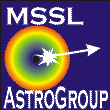

MSSL Astrophysics Group Beginner's Guides
A Beginner's Guide to AGN

The nucleus of a galaxy is said to be `active' if it appears that the light which we measure is greater than that which can be emitted by stars alone.
AGN -
THE ESSENTIAL FACTS
 DISTANCE
DISTANCE
Quasars, very high
luminosity AGN, are the most distant objects in the Universe. They have
been discovered out to redshifts
of about 5, when the Universe was only
one-tenth of its present age (about 10 billion years ago).
 LUMINOSITY
LUMINOSITY
The amount of light
emitted from AGN is immense; a typical object is approximately one million,
million times brighter than our own Sun. This radiation is produced over
the full range of the electromagnetic spectrum, from low-energy radio waves
to high-energy gamma-rays.
 MASS
MASS
By measuring the
luminosity of an AGN, we can find out a minimum level for its mass: usually
around one billion times the mass of the Sun. The rate at which the light
from an AGN can change indicates that this enormous mass is contained within
a region less than one light-day across. Only a `supermassive' black hole
could have such a high density.
 FUEL
FUEL
In order to produce
such vast quantities of light, AGN consume fuel at an enormous rate; the
equivalent of about a few Suns every year. The fuel, surrounding gas and
dust, and probably infalling stars, is dragged in by the huge gravitational
force of the central black hole.
 Explore
the structure of a galactic nucleus with these Quasar
Snapshots
Explore
the structure of a galactic nucleus with these Quasar
SnapshotsWeak, or low-luminosity, AGN are sometimes powered by regions which are dominated by intensive bursts of star formation - these are known as `Starburst Galaxies' - see the section on Narrow Emission Line Galaxies
Other Extragalactic Astronomy pages:
Also - why not try the public
pages of the Hubble Space Telescope for more pictures and
information?
 Return to the
MSSL Astrophysics Group Visitor Centre
Return to the
MSSL Astrophysics Group Visitor Centre Mullard Space Science Laboratory
Mullard Space Science Laboratory Back to the
Mullard Space Science Laboratory homepage
Back to the
Mullard Space Science Laboratory homepage